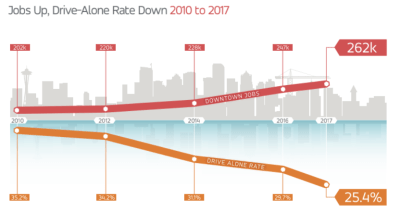More New Yorkers Are Getting to Work Without Getting in Their Cars

New York City is getting to be even more of a transit town. From 2000 to 2013, the share of working New Yorkers who commute by transit rose from 52.6 percent to 59.1 percent, while the share who commute by car dropped from 33.9 percent to 27.4 percent, according to a new analysis from the New York University Furman Center.
The Furman analysis is based on U.S. Census commute data. Not surprisingly, transit commuting is most prevalent in neighborhoods closest to the Manhattan core, such as Upper Manhattan, the South Bronx, western Queens, and northwest Brooklyn.
Transit commuting grew fastest in the South Bronx, Bushwick, Middle Village, Glendale, Brownsville, and East New York, increasing by more than 10 percentage points in those areas since 2000:

In all but three community board districts, more than a third of commuters take transit. The exceptions are Queens community district 11, covering Bayside and Little Neck, and Staten Island community districts 2 and 3, covering Tottenville, Great Kills, South Beach, and Willowbrook.
Bicycling also increased, but the report does not break out the rate of change in different parts of the city.
Instead the report shows neighborhood-by-neighborhood variations in current bike commute rates. Citywide, about 1 percent of New Yorkers choose bicycling as their primary mode of transportation to work. In northwest Brooklyn and the Lower East Side, which have a denser bike lane network, that rises to approximately 4 percent.

Other neighborhoods, the report points out, have higher bicycle commute rates than average but low levels of bicycle infrastructure, including Sunset Park, Borough Park, Flatbush, Midwood, Jackson Heights, Elmhurst, and Corona.
The report also found that higher-density neighborhoods, which tend to be near the city’s core, had shorter average commute times: The city’s densest quarter of neighborhoods had average commutes of 35 minutes, while residents in the least-dense quarter of neighborhoods spent an average of 43 minutes getting to work.

